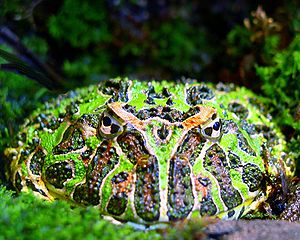The Emerald Tree Boa is extremely popular in zoos and private collections, but its life in the wild remains relatively unstudied. What little we have learned has come mainly from chance observations rather than long-term studies. Cryptic coloration, nocturnal ways and a life spent high in tropical forest canopies or dense brush has served to shroud their habits in mystery. But each bit of knowledge has helped us to better keep and breed this magnificent snake. For example, studies of the Emerald Tree Boa’s natural habitat have revealed the importance of providing captives with humid but airy enclosures, and temperatures that are somewhat lower than one might expect.
Range
Emerald Tree Boas are native to two distinct but adjacent areas of northern South America – the Guyana or Northern Shield region and the Amazon Basin. Individuals from each area differ somewhat in appearance, and some have suggested that 2 subspecies should be named. Corallus batesii has been proposed for the Amazon Basin population by those who believe that 2 distinct species are present.
Description: Differences between the Two Major Populations
Snakes from the Guyana Shield region, which encompasses parts of Surinam, Guyana, French Guiana and Venezuela, are light green in color (often described as “lime green”), and have noticeably larger head scales than do those further south. Read More »
 That Reptile Blog – Reptile, Amphibian and Exotic Pet Care and Information
That Reptile Blog – Reptile, Amphibian and Exotic Pet Care and Information





